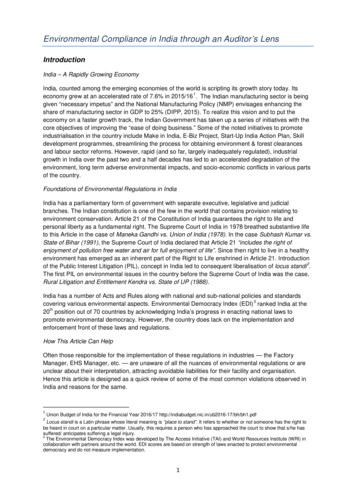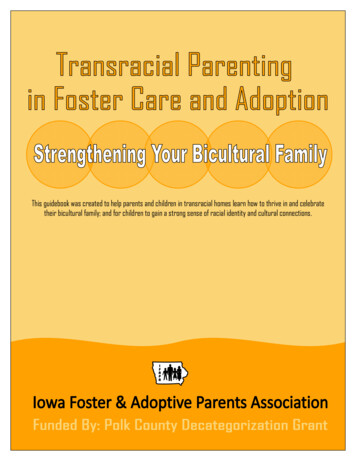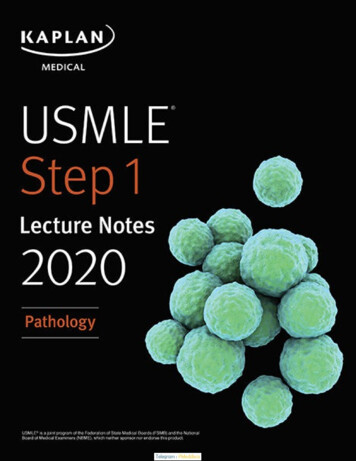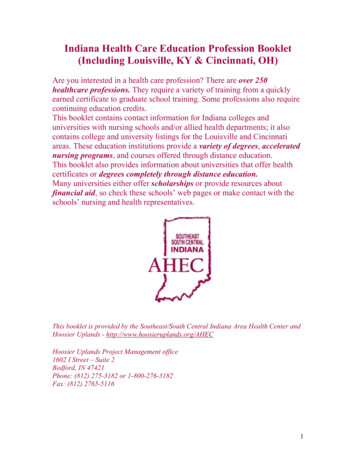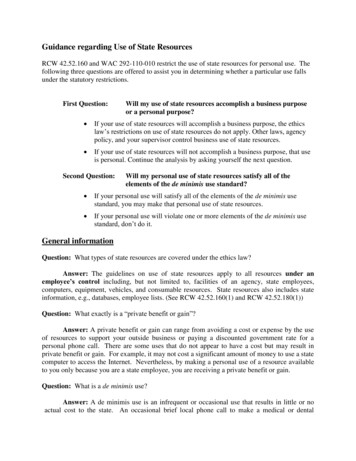
Transcription
CHAPTER RESOURCES Chapter 4 Houghton Mifflin Harcourt Publishing Company Cover Image Credits: (Ground Squirrel) Don Johnston/AllCanada Photos/Getty Images; (Sawtooth Range. Idaho) Ron and Patty Thomas Photography/E /Getty ImagesDivide by 1-Digit NumbersINCLUDES School-Home Letter Vocabulary Game Directions Daily Enrichment Activities Reteach Intervention for every lesson Chapter 4 Test Chapter 4 Performance Task Answer Keys andIndividual Record Forms
Copyright by Houghton Mifflin Harcourt Publishing CompanyAll rights reserved. No part of the material protected by this copyright may be reproduced or utilized in anyform or by any means, electronic or mechanical, including photocopying, recording, broadcasting or by anyother information storage and retrieval system, without written permission of the copyright owner unless suchcopying is expressly permitted by federal copyright law.Only those pages that are specifically enabled by the program and indicated by the presence of the printicon may be printed and reproduced in classroom quantities by individual teachers using the correspondingstudent’s textbook or kit as the major vehicle for regular classroom instruction.Common Core State Standards Copyright 2010. National Governors Association Center for Best Practicesand Council of Chief State School Officers. All rights reserved.This product is not sponsored or endorsed by the Common Core State Standards Initiative of the NationalGovernors Association Center for Best Practices and the Council of Chief State School Officers.HOUGHTON MIFFLIN HARCOURT and the HMH Logo are trademarks and service marks of HoughtonMifflin Harcourt Publishing Company. You shall not display, disparage, dilute or taint Houghton Mifflin Harcourttrademarks and service marks or use any confusingly similar marks, or use Houghton Mifflin Harcourtmarks in such a way that would misrepresent the identity of the owner. Any permitted use of HoughtonMifflin Harcourt trademarks and service marks inures to the benefit of Houghton Mifflin Harcourt PublishingCompany.All other trademarks, service marks or registered trademarks appearing on Houghton Mifflin HarcourtPublishing Company websites are the trademarks or service marks of their respective owners.
ContentsChapter 4 School-Home Letter (English) . 4-1Chapter 4 School-Home Letter (Spanish) . 4-2Vocabulary Game . 4-34.1 Reteach . 4-54.1 Enrich . 4-64.2 Reteach . 4-74.2 Enrich . 4-84.3 Reteach . 4-94.3 Enrich . 4-104.4 Reteach . 4-114.4 Enrich . 4-124.5 Reteach . 4-134.5 Enrich . 4-144.6 Reteach . 4-154.6 Enrich . 4-164.7 Reteach . 4-174.7 Enrich . 4-184.8 Reteach . 4-194.8 Enrich . 4-20Chapter Resources Houghton Mifflin Harcourt Publishing CompanyiiiTable of Contents
4.9 Reteach . 4-214.9 Enrich . 4-224.10 Reteach . 4-234.10 Enrich . 4-244.11 Reteach . 4-254.11 Enrich . 4-264.12 Reteach . 4-274.12 Enrich . 4-28Chapter 4 Test . 4-29Chapter 4 Performance Task . 4-35Answer Keys . 4-40Individual Record Forms . 4-47Chapter Resources Houghton Mifflin Harcourt Publishing CompanyivTable of Contents
School-Home4ChapterLetterDistributive Property The propertythat states that dividing a sum by anumber is the same as dividing eachaddend by the number and thenadding the quotientsDear Family,During the next few weeks, our math class willbe learning how to model division, and use thedivision algorithm to divide up to three-digitdividends by 1-digit divisors. The class willlearn different methods to divide, includingusing models, repeated subtraction, and thestandard division algorithm. We will also learnto divide with remainders.multiple A number that is the productof a given number and a countingnumberremainder The amount left over whena number cannot be divided evenlyYou can expect to see homework that providespractice modeling division and using thedivision algorithm.Here is a sample of how your child will betaught to model division using the DistributiveProperty.Use the Distributive Property to DivideTipsThis is how we will divide using the Distributive Property.Find 72 3.STEP 1STEP 2Draw a rectangle tomodel 72 3.Think of 72 as 60 12. Break apartthe model into two rectangles to show(60 12) 3.?37236012STEP 372 4 3 (60 3) (12 3) 20 4 24So, 72 3 24.Each rectangle models a division.Chapter Resources Houghton Mifflin Harcourt Publishing CompanyWhenever possible, tryto use division facts andmultiples of ten whenbreaking your rectangle intosmaller rectangles. In theproblem at the left, 60 4 3 iseasy to find mentally.4-1
Carta4Capítulopara la casapropiedad distributiva La propiedadque establece que dividir una suma entreun número es lo mismo que dividir cadasumando entre el número y luego sumarlos cocientesQuerida familia,Durante las próximas semanas, en la clase dematemáticas aprenderemos a representar ladivisión y a usar el algoritmo de la división para dividirdividendos de hasta tres dígitos entre divisores de undígito. Para ello, desarrollaremos diferentes métodospara dividir, incluyendo usar modelos, resta repetiday el algoritmo de la división estándar. Tambiénaprenderemos a dividir con residuos.múltiplo Un número que es el productode un número determinado y de unnúmero positivo distinto de ceroresiduo La cantidad sobrante cuandoun número no se puede dividir en partesigualesLlevaré a la casa tareas con actividades pararepresentar la división y para usar el algoritmo de ladivisión.Este es un ejemplo de la manera como aprenderemosa representar la división usando la propiedaddistributiva.Usar la propiedad distributiva para dividirPistasAsí es como dividiremos usando la propiedad distributiva.Halla 72 3.PASO 1PASO 2Dibuja un rectángulopara representar 72 3.Piensa en 72 como 60 12.Divide el modelo en dos rectángulos paramostrar (60 12) 3.?37236012PASO 372 3 (60 3) (12 3) 20 4 24Por tanto, 72 3 24.Cada rectángulo representa una división.Chapter Resources Houghton Mifflin Harcourt Publishing CompanyEn la medida de lo posible,trata de usar operaciones dedivisión y múltiplos de diezcuando dividas el modelo enrectángulos más pequeños. Enel problema anterior, 60 3 esfácil de hallar mentalmente.4-2
Chapter 4Vocabulary GameGoing Places withwordsPick ItGameGameWord BoxFor 3 to 4 playersMaterials 4 sets of word cards.How to Play1. Each player is dealt 5 cards. The remaining cards are a draw pile.2. To take a turn, ask any player if he or she has a word that nddivisormultiplepartial quotientquotientremainderone of your word cards.3. If the player has the word, he or she gives the card to you, and youmust define the word. If you are correct, keep the card and put the matching pair infront of you. Take another turn. If you are wrong, return the card. Your turn is over.4. If the player does not have the word, he or she answers, “Pick it.”Then you take a card from the draw pile. Houghton Mifflin Harcourt Publishing Company Mel Curtis/PhotoDisc/Getty Images5. If the card you draw matches one of your word cards, follow thedirections for Step 3 above. If it does not, your turn is over.6. The game is over when one player has no cards left. The playerwith the most pairs wins.Chapter 4Chapter Resources Houghton Mifflin Harcourt Publishing Company4-3196AGame Directions
Lesson 4.1ReteachNameEstimate Quotients Using MultiplesFind two numbers the quotient of 142 4 5 is between. Thenestimate the quotient.You can use multiples to estimate. A multiple of a number is theproduct of a number and a counting number.Step 1 Think: What number multiplied by 5 is about 142?Since 142 is greater than 10 3 5, or 50, use counting numbers10, 20, 30, and so on to find multiples of 5.Step 2 Multiply 5 by multiples of 10 and make a table.Counting Number10203040Multiple of 550100150200Step 3 Use the table to find multiples of 5 closest to 142.20 3 5 10030 3 5 150142 is between 100 and 150 .142 is closest to 150 , so 142 4 5 is about 30 .Find two numbers the quotient is between. Thenestimate the quotient.1.136 4 6between2.andbetweenabout3.andabout124 4 9between95 4 34.andbetweenaboutChapter Resources Houghton Mifflin Harcourt Publishing Company238 4 7andabout4-5Reteach
Lesson 4.1EnrichNameEstimating QuotientsMatch each quotient with its best estimate. Then write the letter ofthe estimate on the appropriate blank to answer the question below.1.342 4 8about 50E2.93 4 7about 15M3.125 4 6about 12I4.74 4 5about 20T5.275 4 4about 70E6.35 4 3about 40A7.481 4 9about 18T8.127 4 7about 13SWhat did you do to find the missing word?52Chapter Resources Houghton Mifflin Harcourt Publishing Company8644-6137Enrich
Lesson 4.2ReteachNameRemaindersUse counters to find the quotient and remainder.269qw Use 26 counters to represent the dividend, 26. Since you are dividing 26 by 9, draw 9 circles.Divide the 26 counters into 9 equal-sized groups. There are 2 counters in each circle, so the quotient is 2 .There are 8 counters left over, so the remainder is 8 .2 r8269qwDivide. Draw a quick picture to help.7qw66 Use 66 counters to represent the dividend, 66. Since you are dividing 66 by 7, draw 7 circles.Divide 66 counters into 7 equal-sized groups. There are 9 counters in each circle, so the quotient is 9 .There are 3 counters left over, so the remainder is 3.9 r3667qwUse counters to find the quotient and remainder.1.6qw192.3qw144.29 4 3Divide. Draw a quick picture to help.3.39 4 4Chapter Resources Houghton Mifflin Harcourt Publishing Company4-7Reteach
Lesson 4.2EnrichNameRiddle TimeUse the clues to solve the riddles below. Youwill need to know the name for each part of adivision equation. Use the division problemat the right as a reminder.QUOTIENTDIVISORREMAINDER9 r14)‾37DIVIDEND1.My divisor is 5.I am greater than 4 3 5.I am less than 5 3 5.My remainder is 1.What dividend am I?2.My divisor is 9.I am greater than 7 3 9.I am less than 8 3 9.My remainder is 7.What dividend am I?3.My divisor is 8.I am less than 30.I am greater than 3 3 8.My remainder is 5.What dividend am I?4.My divisor is 6.I am less than 60.I am greater than 8 3 6.I have no remainder.What dividend am I?5.My dividend is 50.My remainder is 1.I am an odd number.What divisor am I?6.My dividend is 8 times as large asmy divisor.I am an even number less than 15.What quotient am I?7.My remainder is 8.My dividend is 80.I am a 1- digit number.What divisor am I?8.My dividend is 24.I am 2 more than my quotient.I have no remainder.What divisor am I?9.Use Exercises 1– 8 as models to write your own divisionnumber riddle.Chapter Resources Houghton Mifflin Harcourt Publishing Company4-8Enrich
Lesson 4.3ReteachNameInterpret the RemainderWhen you solve a division problem with a remainder, the way youinterpret the remainder depends on the situation and the question.Way 1: Write the remainder as a fraction.Callie has a board that is 60 inches long.She wants to cut 8 shelves of equal lengthfrom the board and use the entire board.How long will each shelf be?Way 2: Drop the remainder.Callie has 60 beads. She wants to make8 identical bracelets and use as manybeads as possible on each bracelet. Howmany beads will be on each bracelet?7 r4Divide. 60 4 8Divide. 60 4 8The remainder, 4 inches, can be dividedinto 8 equal parts.487 r4The remainder is the number of beadsleft over. Those beads will not be used.Drop the remainder.remainderdivisorWrite the remainder as a fraction.74Each shelf will be 8Callie will use 7 beads on each bracelet.inches long.Way 3: Add 1 to the quotient.Callie has 60 beads. She wants to put8 beads in each container. How manycontainers will she need?Divide. 60 4 8Way 4: Use only the remainder.Callie has 60 stickers. She wants to givean equal number of stickers to 8 friends.She will give the leftover stickers to hersister. How many stickers will Callie giveto her sister?7 r4Divide. 60 4 8The answer shows that Callie can fill7 containers but will have 4 beads leftover. She will need 1 more container forthe 4 leftover beads. Add 1 to the quotient.The remainder is the number of stickersleft over. Use the remainder as theanswer.Callie will need 8 containers.1.Callie will give her sister 4 stickers.There are 35 students going to the zoo.Each van can hold 6 students. Howmany vans are needed?Chapter Resources Houghton Mifflin Harcourt Publishing Company7 r42.4-9Sue has 55 inches of ribbon. She wantsto cut the ribbon into 6 equal pieces.How long will each piece be?Reteach
Lesson 4.3EnrichNameRemainder QuestionsRead each scenario. Use the scenario to write questions that wouldhave the given answers.1.There are 52 students in the fourth grade. Each minivan can hold6 students. The students are going on a field trip.8942.Six friends are going on a hike. Becky made 64 ounces of trail mix.104643.Why is it important to read division problemscarefully before giving the answer?Chapter Resources Houghton Mifflin Harcourt Publishing Company4-10Enrich
Lesson 4.4ReteachNameDivide Tens, Hundreds, andThousandsYou can use base-ten blocks, place value, and basic facts to divide.Divide. 240 4 3Use base-ten blocks.Use place value.Step 1 Draw a quickpicture to show 240.Step 1 Identify the basic fact to use.Step 2 You cannot divide2 hundreds into 3 equalgroups.Rename 2 hundreds as tens.Step 2 Use place value to rewrite240 as tens.240 524Use 24 4 3 .tenstensStep 3 Divide.Step 3 Separate the tensinto 3 equal groups todivide.There are 3 groups ofWrite the answer.240 4 3 524240 524 tens 4 3 585tens.880tensWrite the answer.80240 4 3 580Use basic facts and place value to find the quotient.1.280 4 42.What division fact can you use?280 What division fact can you use?1,800 5tens28 tens 4 4 51,800 4 918 hundreds 4 9 5tens3.560 4 7 54.180 4 6 55.1,500 4 5 56.3,200 4 4 5 Houghton Mifflin Harcourt Publishing Companyhundreds1,800 4 9 5280 4 4 5Chapter Resourceshundreds4-11Reteach
Lesson 4.4EnrichNameDividend RiddlesSolve each riddle.1.When divided by 5, I am 60. Whendivided by 6, I am 50. What numberam I?2.When divided by 3, I am 700. Whendivided by 7, I am 300. What numberam I?3.When divided by 8, I am 70. Whendivided by 7, I am 80. What numberam I?4.When divided by 7, I am 400. Whendivided by 4, I am 700. What numberam I?5.When divided by 6, I am 200. Whendivided by 4, I am 300. What numberam I?6.When divided by 8, I am 30. Whendivided by 6, I am 40. What numberam I?7.Stretch Your Thinking Find the sum of the six answers to the riddles.Write your own riddle so that the answer is this sum.Chapter Resources Houghton Mifflin Harcourt Publishing Company4-12Enrich
Lesson 4.5ReteachNameEstimate Quotients Using Compatible NumbersCompatible numbers are numbers that are easy to computementally. In division, one compatible number divides evenly intothe other. Think of the multiples of a number to help you findcompatible numbers.Estimate. 6qw216Step 1 Think of these multiples of 6:61218243036424854Find multiples that are close to the first 2 digits of the dividend.18 tens and 24 tens are both close to 21 tens . You can useeither or both numbers to estimate the quotient.Step 2 Estimate using compatible numbers.216 4 6216 4 6180 4 6 5 30240 4 6 5 40So, 216 4 6 is between 30 and 40 .Step 3 Decide whether the estimate is closer to 30 or 40.216 2 180 5 36240 2 216 5 24216 is closer to 240, so use 40 as the estimate.Use compatible numbers to estimate the 5786.8qw289Chapter Resources Houghton Mifflin Harcourt Publishing Company4-13Reteach
Lesson 4.5EnrichNameMake the Best EstimateOne of the division expressions in columns A, B, and Cis the best match for the Estimate column. Circle thebest choice for each.Estimate16.ABC1. 70408 78 545816 92. 803 251342 5477 73. 90332 58 6289 7804. 409 350423 8538 95. 100410 2593 64 8496. 4004 1,5845 1,126712 37. 2002,384 53,006 81,742 98. 7002,663 56 3,4117 5,0269. 3002 5324 7672 28910. 120628 83 296483 411. 50115 44 198317 512. 208 274221 76 14113. 9008,250 95,740 82,992 414. 1506 9098 1,0407 88115. 60256 6189 3182 5What strategy didyou use to help you choose the bestmatch?Chapter Resources Houghton Mifflin Harcourt Publishing Company17.Stretch Your Thinking Createthree of your own division expressionsas estimates for Exercise 15. Circle thechoice that has the best estimate.4-14Enrich
Lesson 4.6ReteachNameDivision and the Distributive PropertyDivide. 78 4 6Use the Distributive Property and quick pictures to break apartnumbers to make them easier to divide.Step 1 Draw a quick picture to show 78.Step 2 Think about how to break apart 78.You know 6 tens 4 6 5 10, so use78 5 60 1 18. Draw a quick pictureto show 6 tens and 18 ones.Step 3 Draw circles to show 6 tens 4 6and 18 ones 4 6. Your drawing showsthe use of the Distributive Property.78 4 6 5 (60 4 6) 1 (18 4 6)Step 4 Add the quotients to find 78 4 6.78 4 6 5 (60 4 6) 1 (18 4 6)5 10 135 13Use quick pictures to model the quotient.1.84 4 2.54 3 3.68 2 4.65 5 5.96 8 6.90 6 Chapter Resources Houghton Mifflin Harcourt Publishing Company4-15Reteach
Lesson 4.6EnrichNameTrue or Not True?The Associative Property of Multiplication states that when youchange the grouping of factors, the product remains the same:(3 3 4) 3 5 5 12 3 5, or 60, and 3 3 (4 3 5) 5 3 3 20, or 60.Is the Associative Property also true for division?Complete Exercises 1–4.1.(8 4 4) 4 1 52.(10 4 2) 4 1 53.When you changed the grouping in Exercises 1 and 2,what happened to the quotient?4.Now use the numbers 2, 4, and 8 to write and evaluatea division expression. Then change the grouping of thenumbers and evaluate the new expression.5.When you changed the grouping in Exercise 3, whathappened to the quotient?6.and 8 4 (4 4 1) 5and 10 4 (2 4 1) 5Is the Associative Property true for division?Explain.Chapter Resources Houghton Mifflin Harcourt Publishing Company4-16Enrich
Lesson 4.7ReteachNameDivide Using Repeated SubtractionYou can use repeated subtraction to divide. Use repeatedsubtraction to solve the problem.Nestor has 27 shells to make bracelets. He needs 4 shells foreach bracelet. How many bracelets can he make?Divide. 27 4 4Write 4qw27 .Step 1Step 24qw2724Subtract the divisor23until the remainder is24less than the divisor.19Record a 1 each time24you subtract.152411247243So, Nestor can make 6 bracelets.He will have 3 shells left.1Count the number of times yousubtracted the divisor, 4.14 is subtracted six times with 3 left.127 4 416 r311Use repeated subtraction to divide.1.30 4 4Chapter Resources Houghton Mifflin Harcourt Publishing Company2.24 4 54-173.47 4 7Reteach
Lesson 4.7EnrichNameSubtraction SituationsEach situation below involves repeated subtraction. Read eachsituation. Use the given information to solve the related divisionproblem. Explain your reasoning.1.There are 51 fourth-graders going ona field trip. One group of 16 studentsrides in one van. A second group of16 students rides in a second van. Athird group of 16 students rides in athird van. The 3 students who are leftride in a car.2.Kate bakes 144 cookies for a bakesale. She places 3 cookies in onebag, 3 cookies in a second bag, andso on, until there are no cookies left.She has 48 bags of 3 cookies each.Find the quotient. 144 4 9Find the quotient. 51 4 83.Describe how the given situations helped you solvethe division problems.Chapter Resources Houghton Mifflin Harcourt Publishing Company4-18Enrich
Lesson 4.8ReteachNameDivide Using Partial QuotientsYou can use partial quotients to divide.Divide. 492 4 4PartialquotientsStep 1 Subtract greater multiples of4qw4922 40092280122120the divisor. Repeat if needed.Step 2 Subtract lesser multiples ofthe divisor. Repeat until the remainingnumber is less than the divisor.Step 3 Add the partial quotients.Use rectangular models to recordpartial quotients.10044001004400100100 1 20 1345 123Divide. Use partial quotients.1.10020 3 420334131234922 40080 129220922 8080 121220 3122 1280 120Divide. Use rectangular models to record thepartial quotients.2.3 qw657100 3400100 3 4852 4 6 5100100 333Chapter Resources Houghton Mifflin Harcourt Publishing Company14-19Reteach
Lesson 4.8EnrichNameSpecial DeliveryMailbox #2 only accepts letters with numbers that can beevenly divided by 2.Mailbox #3 only accepts letters with numbers that can beevenly divided by 3.Mailbox #5 only accepts letters with numbers that can beevenly divided by 5.1.Deliver the letters by writing each number below the correctmailbox. Some letters will be 5355120163339#3925#5Could any letter be delivered to all three mailboxes?Explain your reasoning.Chapter Resources Houghton Mifflin Harcourt Publishing Company4-20Enrich
Lesson 4.9ReteachNameModel Division with RegroupingYou can use base-ten blocks to model division with regrouping.Use base-ten blocks to find the quotient 65 4 4.Step 1 Show 65 with base-ten blocks.Step 2 Draw 4 circles to represent dividing65 into 4 equal groups. Share the tensequally among the 4 groups.Step 3 Regroup leftover tens as ones.Step 4 Share the ones equally among the4 groups.There are 1 ten(s) and 6 one(s) ineach group with 1 left over.So, the quotient is16 r1.Divide. Use base-ten blocks.1.37 4 2Chapter Resources Houghton Mifflin Harcourt Publishing Company2.74 4 33.4-2166 4 5Reteach
Lesson 4.9EnrichNameDivision DryingTo find the answer to the riddle, complete each division.Then use the KEY to find the answer to the riddle.1.78 4 62.58 4 33.92 4 44.88 4 75.57 4 26.89 4 5KEY:ADELOTUVW1323 r128 r117 r42319 r117 r216 r212 r4Riddle: The more I dry, the wetter I get. What am I?17.23456Stretch Your Thinking Make up a new division problem forExercise 2 so that when using the quotient and the key, the result willbe the answer to this riddle: “What is the difference between SHELLand SHALL?”Chapter Resources Houghton Mifflin Harcourt Publishing Company4-22Enrich
Lesson 4.10ReteachNamePlace the First DigitDivide. 763 4 3 5Step 1 Estimate. Then divide the hundreds.23qw763261Think: 3 3 1 hundred 5 3 hundreds3 3 2 hundreds 5 6 hundreds3 3 3 hundreds 5 9 hundredsDivide 7 hundreds by 3.Multiply. 3 3 2 hundredsSubtract.3 3 3 hundreds is too large.Use 2 hundreds as an estimate.23qw7632616Step 2 Bring down thetens digit. Then dividethe tens.Step 3 Bring down theones digit. Then dividethe ones.253qw76326Bring down16215the 6.1253qw763262543qw7632616215162 1513Bring downthe 3.Step 4 Check to make sure that the remainder isless than the divisor. Write the answer.Divide 16 tens by 3.Multiply. 3 3 5 tensSubtract.Divide 13 ones by 3.132 121Multiply. 3 3 4 onesSubtract.254 r13qw7631,3Divide.1.2qw531Chapter Resources Houghton Mifflin Harcourt Publishing Company2.4qw6283.4-239qw3494.7qw794Reteach
Lesson 4.10EnrichNameHow Many Digits?Circle how many digits will be in the quotient. Find the quotient tocheck that you are correct. Then, look at the riddle below. To answerthe riddle, write the letter of the number you circled on the line abovethe exercise number.1.346 4 2 515P3.25R35H6.35W15C8.25M35E35C25S35N162 4 6 515G420 4 7 525A210 4 5 515R120 4 8 525C108 4 9 515T4.25I15S7.35N652 4 4 515L5.2.25E35J444 4 4 15K25E35I164What can run but cannot walk?725Chapter Resources Houghton Mifflin Harcourt Publishing Company384-24Enrich
Lesson 4.11ReteachNameDivide by 1-Digit NumbersDivide. 766 4 6 51Step 1 Use place value to place the first digit.6qw766Think: 7 hundreds can be shared among6 groups without regrouping.1Step 2 Bring down the 6qw76626tens digit. Then divide16the tens.126qw7662616Bring down212the 6.41212Step 3 Bring down the 6qw766ones digit. Then divide26the ones.16212461271276qw7662616212462424Bring downthe 6.Step 4 Check to make sure that the remainderis less than the divisor. Write the answer.Step 5 Use multiplication and addition to checkyour answer.Divide 16 tens by 6.Multiply. 6 3 2 tensSubtract.Divide 46 ones by 6.Multiply. 6 3 7 onesSubtract.127 r46qw7664,61273 676214766Divide and check.1.4qw868Chapter Resources Houghton Mifflin Harcourt Publishing Company2.2qw6573.4-257qw8,473Reteach
Lesson 4.11EnrichNameWhat Is Left Over ?Find the “leftover” in each situation. Then use the code key to seewhich letters match each of your answers. Write the letters in orderof the exercises to find the answer to the riddle.1.Jude puts 6 lemons in each bag. If he has 170 lemons,how many will be left over?2.Selena has a piece of ribbon that is 130 inches long. If shewants to make bracelets that are 9 inches long, how manyinches of ribbon will be left over?3.Justin prepares 229 hamburgers for a company picnic. Ifbuns come in packages of 8, how many will be left over?4.Mrs. Bradley has 204 to divide equally between her7 grandchildren. How many dollars will she have left over?5.Mr. White has 115 tulips for bouquets. He puts 9 tulips ineach bouquet. How many tulips will be left over?12345678GFELANSTWhat flies around all day but never goes anywhere?Chapter Resources Houghton Mifflin Harcourt Publishing Company4-26Enrich
Lesson 4.12ReteachNameProblem Solving Multistep Division ProblemsThere are 72 third graders and 84 fourth graders going on a fieldtrip. An equal number of students will ride on each of 4 buses.How many students will ride on each bus?Read the ProblemSolve the ProblemWhat do I need to find?I need to find the number of students whowill ride on each bus.I can model the number of students in allusing a bar diagram.72What information do I need to use?72There arethird graders and84fourth graders. There will be4buses.84156I can model the number of buses anddivide to find the number of students oneach bus.How will I use the information?I will make a bar diagram for each step. Iwill add 72 and 84 to find the total numberof students. I will divide by 4 to find howmany students will ride on each bus.393939156So,39students will ride on each bus.1.Miranda has 180 beads for making jewelry. She buys 240 morebeads. She wants to store the beads in a case with 6 sections.She wants to put the same number of beads in each section.How many beads should Miranda put in each section?2.All 203 students at Polk School eat lunch at the same time. Oneday 19 students were absent. If 8 students sit at each table inthe lunchroom, how many tables were used that day at lunch?Chapter Resources Houghton Mifflin Harcourt Publishing Company394-27Reteach
Lesson 4.12EnrichNameIt’s a Riddle!Solve each problem. Look for the answer in the riddle below andwrite the letter of the problem on the line. Not all letters will be used.CMaria takes 24 photos at the circusand 72 photos on her vacation. Ifeach page in her scrapbook canhold 6 photos, how many pages canMaria fill?ICarmen and Wayne sell 25birdhouses at a craft fair. They sharethe money equally. If each birdhousecosts 14, how much money willCarmen and Wayne each receive?RJosé uses 3 flowers for eachcorsage he makes. He has ordersfor 18 corsages each from twodifferent stores. How many flowerswill he need?LMr. Davis sells sleeping bags. He has30 red sleeping bags and 26 greensleeping bags to put on shelves.Each shelf ca
Any permitted use of Houghton Mifflin Harcourt trademarks and service marks inures to the benefit of Houghton Mifflin Harcourt Publishing Company. All other trademarks, service marks or registered trademarks appearing on Houghton Mifflin Harcourt Publishing Company websites are th



